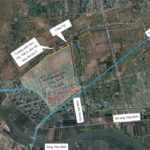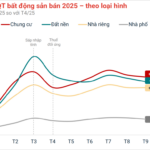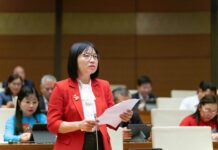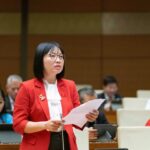The Hai Phong City Party Committee’s Standing Board has tasked the City People’s Committee Party Committee with directing relevant units to implement the investment procedures for the East-West connectivity road project. This road will link National Highway 10 with the former Hai Duong City’s Ring Road 1. Identified as a priority project for the 2026-2030 period, it aims to enhance connectivity and economic development.
According to the Hai Phong Department of Construction, the current transportation link between the western urban area (the core of the former Hai Duong City) and the eastern area (former Hai Phong City) primarily relies on National Highway 5 and the Hanoi-Hai Phong Expressway. However, these routes have shown limitations, causing bottlenecks that hinder economic growth.
The proposed East-West connectivity road aims to shorten travel time between the western urban center and Hai Phong City, fostering seamless connections among urban, economic, industrial, port, aviation, and logistics hubs.
This project will create new development spaces, leverage local potential, and drive growth, holding significant political, administrative, and socio-economic importance for Hai Phong post-merger.

Illustrative image of the proposed East-West connectivity road in Hai Phong City.
The project is designed with a 110m-wide corridor, spanning approximately 23.5km through the communes/wards of Nam Dong, Ai Quoc, Ha Tay, Thanh Ha, Ha Bac, Ha Nam, Kim Thanh, An Phong, and An Duong. The main carriageway will feature a 68m cross-section, a minimum design speed of 80km/h, and one-way traffic flow with six lanes.
The road will include a median strip, emergency stopping lanes, and parallel lanes for motorcycles and cars with a maximum speed of 60km/h. The median strip will reserve land for future modern public transport systems like BRT and ART.
The 42m-wide road reserves on both sides will accommodate frontage roads to support local traffic needs, facilitating urban, service, and industrial development.
Hai Phong City plans to develop 11,700 hectares for industrial zones, eco-urban areas with high-tech agriculture, and commercial urban services. This includes 2,200 hectares for new urban and commercial services, 2,300 hectares for industrial development, and 7,000 hectares for high-tech agriculture, infrastructure, and green spaces.
Four investment models are proposed: public-private partnerships (PPP), build-transfer (BT) with land fund and budget payments, PPP with 100% investor capital and land fund payments, and public investment using budget or ODA loans.
The city plans to allocate 650-700 hectares of land designated for urban, service, and commercial development, or alternative land funds, to compensate investors, ensuring balanced payments.
Haiphong Plans $840 Million Investment in East-West Road Connectivity Project
The city of Hai Phong is developing a plan to construct a 23.5-kilometer road connecting the former Hai Duong City to the heart of Hai Phong. This ambitious project boasts a total investment of over 19.1 trillion Vietnamese Dong.
Eastern Real Estate Market Gains Momentum as Infrastructure Projects Accelerate in the Final Quarter
Real estate in Binh Duong, Dong Nai, Long An, and Ba Ria – Vung Tau (formerly known as such before consolidation) is emerging as a highlight towards the end of the year. Among these, the former Binh Duong area is garnering the most attention, thanks to its advantages in migrant population, land availability, and transportation infrastructure.
CEO Group to Break Ground on $120 Million Industrial Park in Hai Phong by Year-End
Unveiling the Tien Lang Airport Industrial Park – Zone B, a groundbreaking 186-hectare development with a total investment of over 2.795 billion VND, spearheaded by a subsidiary of CEO Group. This visionary project aims to establish an eco-friendly, high-tech industrial zone, slated to commence construction by year-end.
Hotspots in Ho Chi Minh City Attracting Significant Investment from Homebuyers
After a prolonged period of suppressed demand for apartments in Ho Chi Minh City due to a scarcity of residential units, the recent influx of new condominium projects has significantly stimulated buyer interest. This surge in supply has ignited vibrant market activity, creating hotspots that are attracting substantial investment from homebuyers.













































